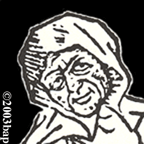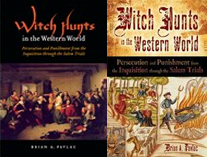Ten Theories about the Origins of the Witch Hunts
Like the Holocaust/Shoah/Final Solution (the attempted extermination of Jews and others by the Nazis in the mid-20th Century), the Witch Hunts demand some sort of explanation.
The "theories" for the causes of the Witch Hunts listed below are drawn from what various historians have suggested. They are called theories, because they are based on reasonable information (or were, when they were first proposed), and make some sense in explaining the phenomena. Each theory below describes the main idea briefly, and after "BUT" lists some of the problems in applying the theory to witch hunts.
None is perfect, some are better than others, and a few are now supported by
only few historians. Some better explain certain hunts in specific places during
limited periods. No one explanation or theory will suffice to explain all Witch Hunts in Europe from 1400 to 1800. To understand the Witch Hunts in their totality, we must keep all
of the theories in mind, and even look for more still. Multiple causation is merely common sense. Any historian who tries to apply one cause to the hunts, or even perhaps to just one hunt, is being too simplistic.
1. Illness Theories: These are variously related to physical and mental conditions of people involved in the hunts. According to a
Mass Hysteria Theory, peasants went a little wacky, becoming clinically neurotic and even psychotic, and in a group panic went after the witches. According to a
Delusion Theory, credence given to childrens fantasies and psychosomatic illnesses are some sources for the panic. Further, a
Disease Theory suggests syphilis or ergotism (caused by mold on rotten bread) as causes for mental instability. Similarly,
Drug Theory suggests that the effects of consuming bad mushrooms, herbs like deadly nightshade or henbane, or bufotenine from the skin of some toads could have affected peoples minds.
BUT, it is hard to explain how so many people, even in one area, could become seriously
ill or disturbed all at once. Additionally, an important characteristic of the witch hunts were their systematic organization by ruling elites and government officials, not some chaotic outbreak.
![]()
2. The Geographic Origins Theories: The Witch Hunts originated in specific locations, for example first in mountainous regions of the Alps and Pyrenees or out of economic differentiation between regions which were normally self-sufficient suddenly caught in new competition because of the commercial revolution.
BUT these explanations are contradicted by counter examples (regions where the lowlands first hunted and then spread to the hills), or the difficulty of quantifying economic differences.
![]()
3. The Disaster Theory: As actual misfortunes struck (plague, famine, war, storm), people blamed supernatural forces and found scapegoats in witches.
BUT many persecutions were done during times of relative peace and plenty. Further, many such troubles were not new to early modern Europe, but have been endemic throughout history. Thus, why were "witches" to blame, and not other common scapegoats (Jews, Sodomites, deviants, foreigners) or other supernatural forces (such as demons without the aid of human witches)?
![]()
4. The Greed Theory: Elites initiated the hunts in order to confiscate property of others.
BUT many persecuted people did not have much wealth. And, in many hunts property was not confiscated, even from very wealthy targets.
![]()
5. The (Mistaken) Conspiracy Theory: Through most of the Middle Ages, demons and witches were insignificant to the Christian belief system. Then in the Late Middle Ages, religious elites in Western Europe created a new,
and mistaken, intellectual framework out of Christian heresy and theology concerning demons.
They linked the idea of witches to an imagined organized sect which was a danger to the Christian commonwealth. Thus authorities sincerely believed in and acted against this Satanic threat, even though it did not really exist according to most theologians before and after as well as many during the time period.
BUT how could a rather minor idea, with so little supporting evidence, lead to such enormous efforts by so many people, especially those with little to gain? In other words, how did an intellectual fashion move so many to physical action?
![]()
6. The Religious Rebellion Theories: These theories are of two kinds:
A. First, the Satanic Religious Rebellion Theory: devil worship actually existed, in particular as a subversive attack on the ruling Christian order. Early historians of witchcraft, such as Jules Michelet (1862) or Montague Summers, take the tortured confessions of witches at their word.
BUT no credible evidence supports the
existence of any actual Satanic cults before the 19th century.
See Myth #8.
B. Second, the Pagan Religious Rebellion Theory: Certain forms of worship from the ancient world continued through the Early Modern period and was misinterpreted by the Christian hunters as Satanic. This theory was formulated by the
Folklorist Margaret Murray, author of The Witch-cult in Western Europe (1921), and The European Witch Cult (1926), The God of the Witches (1960). She said worship of the horned god Janus or "Dianus" was focus of pagan continuity into modern times. It could be called the Murrayite Theory, and it remains popular in Neo-pagan circles.
BUT no credible evidence reveals the survival of much paganism or any organized fertility cults, beyond common superstition and simple folk traditions. Professional scholars have largely discredited Murray’s work. See Myth #8 and Myth #10.
![]()
7. The Confessional Conflict Theory: Reformation and its resultant fights between Protestants (mainly Lutherans, Calvinists and Anabaptists, as well as Anglicans) and Roman Catholics led each to use witchcraft to attack one another.
BUT adherents of one branch of Christianity only rarely used the accusation of witchcraft specifically to persecute someone of another branch. Usually the Witch Hunts were carried out by people of the same type of
Christianity as the victims.
See also Myth #2.
![]()
8. The Social Control or State-building Theory:
Early modern governments exploited the fear of witchcraft in order to centralize authority, increase bureaucratic jurisdiction, impose cultural uniformity, and dominate the Church. The hierarchy may have believed in witchcraft or not, but a dangerous conspiracy provided the premise for expanding government intervention. This theory has a certain similarity to The Church Oppression Theory, popular in the 19th century but held by few today, according to which the Church fraudulently invented witches so as to crush its opponents and grow rich.
BUT why should witchcraft be the specific target in these years? And why should the hunts be so vicious, and as a result cause such disturbances in the state? And the theory gives too much credit to the elites over the "ignorant" masses.
![]()
9. The Social Functionalist or Social Accusations Theory:
Witch accusers acted on a psychological need to blame others for their own personal problems. Drawing on functionalist anthropology, psychology and post-modernist criticism, supporters of this theory argue that witch hunts were therapeutically beneficial for society, since they defined what was right and wrong and rid society of its troublesome marginalized folk, like the old and the poor. Thus the hunts functioned to reinforce and define social boundaries of moral and acceptable behavior.
BUT these theories do not take into account motives of individual accusations (such as local feuds and grudges), and contemporary explanations of those involved (the religious and political context). And why should the hunts be so vicious? And again, why should witchcraft be the specific target in these years?
![]()
10. The Misogyny Theory: The Witch Hunts embodied a social hostility toward women. Such theories are often tied with
popularizing feminist writers, who might also see in witchcraft a source of empowerment for women.
Indeed, the ongoing subordination of women, womens connection to folk-magic and healing,
and changing views of womens social and economic place in Early Modern Europe were important factors in the hunts. The majority of accused
and executed were female, yet also old, living alone (whether widowed or spinster), and poor.
BUT, such theories exaggerate the proportions of women involved and the extent to which women were the focus.
See Myth #4. Men in some witch hunts were the majority of victims; and some hunts persecuted children of both sexes.
CITATION
If you use any information from this page, be sure to properly cite it, for example using the following format:
Pavlac, Brian A. "Ten Theories about the Origins of the Witch Hunts," Prof. Pavlac's Witch Hunts Page. (9 August 2017). URL: <www.brianpavlac.org/witchhunts/wtheories.html> (date accessed).
For a list of the most useful books on the witch hunts, click here.
![]()
| Ten Theories about the Causes of the Witch Hunts | Ten Common Errors and Myths about the Witch Hunts | Timeline of the Witch Hunts |
| tba | Sources for Salem Witch Hunt | 
|
| Primary Source: Letters from the Witch Trial of Rebecca Lemp: a family deals with accusations. |
Torture: a review of torture in the witch hunts and today. |
Suffer your own persecution! Try a witch hunt simulation: make choices to survive or not. |

 Buy the Book!
Buy the Book!

